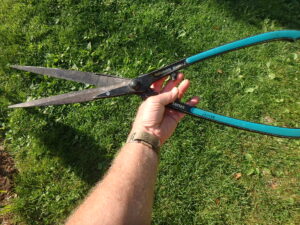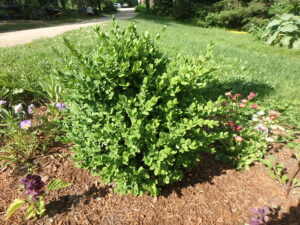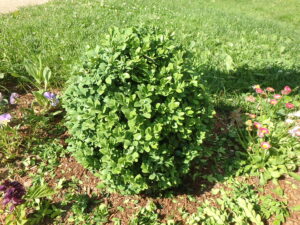It’s Time to Prune Trees and Shrubs
Posted on Sunday, June 27, 2021 · Leave a Comment
By now your rhododendrons, lilacs and other spring bloomers have bloomed, and are ready to prune. By pruning now, you will not damage buds that will form later this summer and bloom next spring. This is also a good time to prune evergreens like pines and hemlocks if you are trying to control their size.
Let’s start with rhododendrons and azaleas, as many gardeners seem to put off pruning them until they are blocking the view out the windows. If you just want to keep your rhododendrons the same size this year as they were last year, pruning it easy: you just look at the color of the stems, and cut off the new growth which is bright green. Older growth is tan or brown.

Use good sharp hedge shears to prune boxwood
Make your cuts just into the green growth. By doing so you are leaving a growing point for new growth next spring. Most rhododendrons blossom on old wood, which is to say growth that occurred the year before.
But what if you want to seriously reduce the size of your azalea or rhododendron? You can make your cuts farther down the stems. Make cuts just above a fork or place where branches grow in two or more directions. You will be cutting away the growth of two, or even three years growth. There are dormant buds on those bare stems, and they will start new growth. The farther down the stem you cut, the longer it will take for growth to begin.
Most rhododendrons keep their leaves all year, but many azaleas drop their leaves and grow all new leaves each year. The old leaves of evergreen species will be a darker color than new leaves, making it easy to see new growth. By the time you read this – depending on your climate – some evergreen rhododendrons will have sent out new shoots after the flowers bloomed. In the middle of a cluster of light green leaves you may see a small very pointed bud. That is next year’s flower.
If you want to shape or reduce the size of your shrub and see new leaves and flower buds, you must make a decision: which is more important? Next year’s show of flowers, or getting your shrub under control? I say (as the Red Queen said in Alice and Wonderland), “Off with its head!” Since pruning is so easily put off for another year, just do it now – even if it means sacrificing some blossoms. There should always be more blossom buds that will appear later this summer.
Lilacs should ideally be pruned two to three weeks after pruning, but can be done now, too. Buds are developed over the summer at the tips of branches to bloom next spring.
If your lilacs are not blooming as well now as they have in the past, it may be because the soil pH has gotten acidic from acid rain, or from pine needles. You can collect a soil sample and send it off to your state Extension Service for testing, but if only want to know the pH, you can buy a simple test kit at your local garden center or hardware store.
Lilacs perform best with a soil that is near neutral (pH 7.0), or slightly higher and more alkaline. The soil test or pH kit will tell you how many pounds of lime to add per hundred square feet, but that is difficult to translate into action. So often I just wing it: I add lime around the base of a lilac and out three or four feet all around. I measure it out in a one-quart yogurt container. One quart for small lilacs, two for big ones. Not precise, but it helps. Do that now – lime takes time to change the pH.
If you have a pine, hemlock or spruce in your yard or up against you house, you would probably prefer it to stay the same size, or at least not to tower over the house. It’s easy to do: YOU MUST PRUNE OFF THE NEW GROWTH EVERY YEAR. Just look at the tips of the branches now. You will see that this year’s growth is a slightly different color than the rest of the branch. Just snip that off. Do it right away, this is the time to do it.

This young boxwood needs a light haircut to shape it
British gardeners – and hence, many American gardeners – love boxwoods. They love hedges and portly round balls. Some even create rabbits and other silly sculpture called topiary. If you have boxwoods, they need a light haircut every year in June or July. Never prune them after August, because pruning stimulates new growth and it will be tender, and turn brown and ugly in winter.
Prune your boxwoods with a good pair of hedge shears. Mine are about 24 inches long, with 9-inches long blades. Don’t use old rusty ones, buy a good pair such as those made by Fiskars or Barnell. Most Fiskars tools are good quality, and sold at a reasonable price. I don’t recommend electric hedge shears because they can ruin a shrub in the time it takes you to sneeze. I like light-weight shears for big jobs.

The same boxwood after pruning
When pruning boxwoods, just take a little off with each snip. You can work quickly, but just take a little at a time so you can get the exact shape you want and don’t create holes with a big cut.
Pruning can be fun. You can create a lovely piece of art if you take your time and step back to look at it as you go along. And if you goof, and create an “oops”, well it will all grow back. So go for it!
Henry is a professional pruner and
gardening consultant living in Cornish Flat, NH. Reach him at PO Box 364, Cornish Flat, NH 03746. Please include a SASE if you want a response by mail. E-mail is better and faster:
henry.homeyer@comcast.net.





